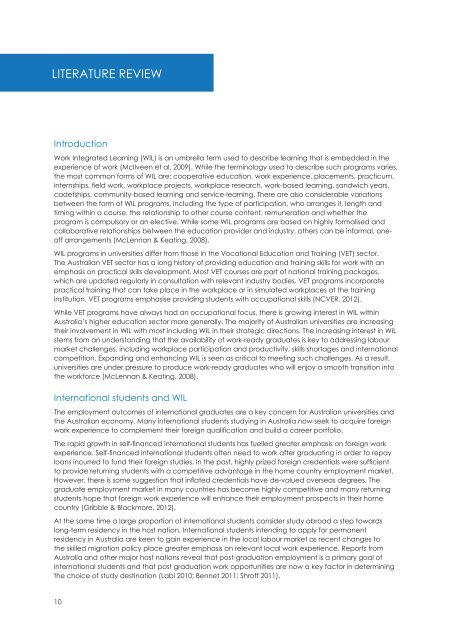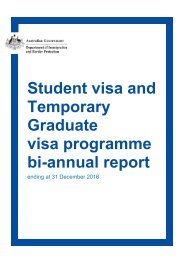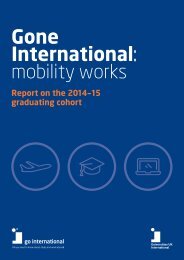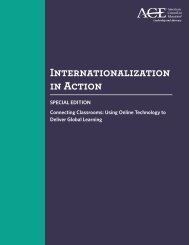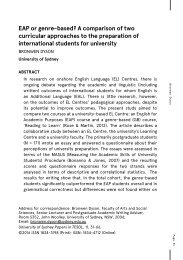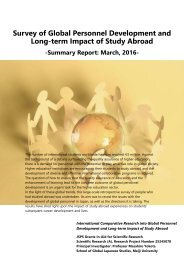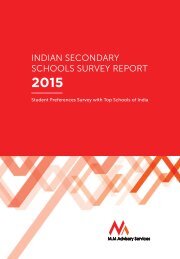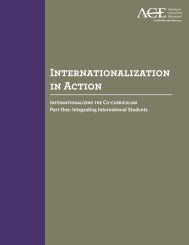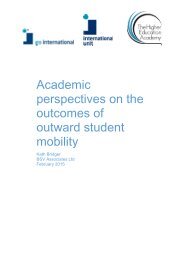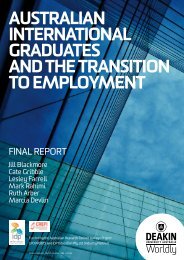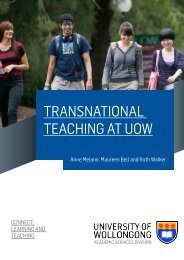internships-and-work-placement-opportunities-for-international-students-in-victoria-ieaa-report-october-2012
internships-and-work-placement-opportunities-for-international-students-in-victoria-ieaa-report-october-2012
internships-and-work-placement-opportunities-for-international-students-in-victoria-ieaa-report-october-2012
Create successful ePaper yourself
Turn your PDF publications into a flip-book with our unique Google optimized e-Paper software.
LITERATURE REVIEW<br />
Introduction<br />
Work Integrated Learn<strong>in</strong>g (WIL) is an umbrella term used to describe learn<strong>in</strong>g that is embedded <strong>in</strong> the<br />
experience of <strong>work</strong> (McIlveen et al, 2009). While the term<strong>in</strong>ology used to describe such programs varies,<br />
the most common <strong>for</strong>ms of WIL are: cooperative education, <strong>work</strong> experience, <strong>placement</strong>s, practicum,<br />
<strong><strong>in</strong>ternships</strong>, field <strong>work</strong>, <strong>work</strong>place projects, <strong>work</strong>place research, <strong>work</strong>-based learn<strong>in</strong>g, s<strong>and</strong>wich years,<br />
cadetships, community-based learn<strong>in</strong>g <strong>and</strong> service-learn<strong>in</strong>g. There are also considerable variations<br />
between the <strong>for</strong>m of WIL programs, <strong>in</strong>clud<strong>in</strong>g the type of participation, who arranges it, length <strong>and</strong><br />
tim<strong>in</strong>g with<strong>in</strong> a course, the relationship to other course content, remuneration <strong>and</strong> whether the<br />
program is compulsory or an elective. While some WIL programs are based on highly <strong>for</strong>malised <strong>and</strong><br />
collaborative relationships between the education provider <strong>and</strong> <strong>in</strong>dustry, others can be <strong>in</strong><strong>for</strong>mal, oneoff<br />
arrangements (McLennan & Keat<strong>in</strong>g, 2008).<br />
WIL programs <strong>in</strong> universities differ from those <strong>in</strong> the Vocational Education <strong>and</strong> Tra<strong>in</strong><strong>in</strong>g (VET) sector.<br />
The Australian VET sector has a long history of provid<strong>in</strong>g education <strong>and</strong> tra<strong>in</strong><strong>in</strong>g skills <strong>for</strong> <strong>work</strong> with an<br />
emphasis on practical skills development. Most VET courses are part of national tra<strong>in</strong><strong>in</strong>g packages,<br />
which are updated regularly <strong>in</strong> consultation with relevant <strong>in</strong>dustry bodies. VET programs <strong>in</strong>corporate<br />
practical tra<strong>in</strong><strong>in</strong>g that can take place <strong>in</strong> the <strong>work</strong>place or <strong>in</strong> simulated <strong>work</strong>places at the tra<strong>in</strong><strong>in</strong>g<br />
<strong>in</strong>stitution. VET programs emphasise provid<strong>in</strong>g <strong>students</strong> with occupational skills (NCVER, <strong>2012</strong>).<br />
While VET programs have always had an occupational focus, there is grow<strong>in</strong>g <strong>in</strong>terest <strong>in</strong> WIL with<strong>in</strong><br />
Australia’s higher education sector more generally. The majority of Australian universities are <strong>in</strong>creas<strong>in</strong>g<br />
their <strong>in</strong>volvement <strong>in</strong> WIL with most <strong>in</strong>clud<strong>in</strong>g WIL <strong>in</strong> their strategic directions. The <strong>in</strong>creas<strong>in</strong>g <strong>in</strong>terest <strong>in</strong> WIL<br />
stems from an underst<strong>and</strong><strong>in</strong>g that the availability of <strong>work</strong>-ready graduates is key to address<strong>in</strong>g labour<br />
market challenges, <strong>in</strong>clud<strong>in</strong>g <strong>work</strong>place participation <strong>and</strong> productivity, skills shortages <strong>and</strong> <strong><strong>in</strong>ternational</strong><br />
competition. Exp<strong>and</strong><strong>in</strong>g <strong>and</strong> enhanc<strong>in</strong>g WIL is seen as critical to meet<strong>in</strong>g such challenges. As a result,<br />
universities are under pressure to produce <strong>work</strong>-ready graduates who will enjoy a smooth transition <strong>in</strong>to<br />
the <strong>work</strong><strong>for</strong>ce (McLennan & Keat<strong>in</strong>g, 2008).<br />
International <strong>students</strong> <strong>and</strong> WIL<br />
The employment outcomes of <strong><strong>in</strong>ternational</strong> graduates are a key concern <strong>for</strong> Australian universities <strong>and</strong><br />
the Australian economy. Many <strong><strong>in</strong>ternational</strong> <strong>students</strong> study<strong>in</strong>g <strong>in</strong> Australia now seek to acquire <strong>for</strong>eign<br />
<strong>work</strong> experience to complement their <strong>for</strong>eign qualification <strong>and</strong> build a career portfolio.<br />
The rapid growth <strong>in</strong> self-f<strong>in</strong>anced <strong><strong>in</strong>ternational</strong> <strong>students</strong> has fuelled greater emphasis on <strong>for</strong>eign <strong>work</strong><br />
experience. Self-f<strong>in</strong>anced <strong><strong>in</strong>ternational</strong> <strong>students</strong> often need to <strong>work</strong> after graduat<strong>in</strong>g <strong>in</strong> order to repay<br />
loans <strong>in</strong>curred to fund their <strong>for</strong>eign studies. In the past, highly prized <strong>for</strong>eign credentials were sufficient<br />
to provide return<strong>in</strong>g <strong>students</strong> with a competitive advantage <strong>in</strong> the home country employment market.<br />
However, there is some suggestion that <strong>in</strong>flated credentials have de-valued overseas degrees. The<br />
graduate employment market <strong>in</strong> many countries has become highly competitive <strong>and</strong> many return<strong>in</strong>g<br />
<strong>students</strong> hope that <strong>for</strong>eign <strong>work</strong> experience will enhance their employment prospects <strong>in</strong> their home<br />
country (Gribble & Blackmore, <strong>2012</strong>).<br />
At the same time a large proportion of <strong><strong>in</strong>ternational</strong> <strong>students</strong> consider study abroad a step towards<br />
long-term residency <strong>in</strong> the host nation. International <strong>students</strong> <strong>in</strong>tend<strong>in</strong>g to apply <strong>for</strong> permanent<br />
residency <strong>in</strong> Australia are keen to ga<strong>in</strong> experience <strong>in</strong> the local labour market as recent changes to<br />
the skilled migration policy place greater emphasis on relevant local <strong>work</strong> experience. Reports from<br />
Australia <strong>and</strong> other major host nations reveal that post-graduation employment is a primary goal of<br />
<strong><strong>in</strong>ternational</strong> <strong>students</strong> <strong>and</strong> that post graduation <strong>work</strong> <strong>opportunities</strong> are now a key factor <strong>in</strong> determ<strong>in</strong><strong>in</strong>g<br />
the choice of study dest<strong>in</strong>ation (Labi 2010; Bennet 2011; Shroff 2011).<br />
10


